Strengthening and Thermally Activated Processes in an AX61/Saffil Metal Matrix Composite
Abstract
1. Introduction
- load transfer of the applied stress to the well bonded fibres (ΔσLT) [32];
- generation of thermal dislocations due to a significant difference between the thermal expansion coefficient (∆α) of metallic matrix and ceramic fibres (ΔσCTE) [33];
- dislocations geometrically necessary that are crated in order to accommodate large strain gradient and allowing compatible deformation (ΔσGEO) [34];
- Hall–Petch strengthening due to finer grain structure in the composite compared with the unreinforced alloy (ΔσHP);
- Orowan strengthening (ΔσOR) [35];
- residual thermal stresses in the matrix (ΔσTH) [36].
2. Materials and Methods
3. Results
4. Discussion
4.1. Strenghtening Influence of Fibres
4.2. Hardening in the Matrix
4.3. Thermally Activated Processes
5. Conclusions
- Saffil fibres reinforced the alloy significantly when the fibre plane was parallel to the stress axis.
- The load transfer (when the fibres plane was parallel to the stress axis) is a significant strengthening mechanism.
- The dislocation density increase due to a significant difference in the thermal expansion coefficient of the matrix and ceramic reinforcement is also important contribution to the strengthening.
- Components of the stress acting in the matrix were estimated at three temperatures.
- All values of the activation volume follow one “master curve” independently on the stress, temperature and orientation of the fibres plane.
- Values of the activation volume of units and tens of b3 and activation energy of ~ 1 eV indicate that the main thermally activated process is very probably dislocation motion in non-compact planes.
Author Contributions
Funding
Conflicts of Interest
References
- Advesian, M.M. ASM Speciality Handbook: Magnesium and Magnesium Alloys; Advesian, M.M., Baker, H., Eds.; ASM International: Russell Township, OH, USA, 1999. [Google Scholar]
- Pekguleryuz, M. Creep Resistant Magnesium Alloys for Power-Train Applications. In Magnesium Alloys and Their Applications; Kainer, K.U., Ed.; DGM, Willey-VCH: Weinheim, Germany, 2003; pp. 65–85. [Google Scholar]
- Ninomiya, J.R.; Ojiro, T.; Kubota, K. Improved heat resistance of Mg-Al alloys by the Ca addition. Acta Metall. 1995, 43, 669–674. [Google Scholar] [CrossRef]
- Gjestland, H.; Nussbaum, G.; Regazzoni, G.; Lohne, O.; Bauger, Ø. Stress-relaxation and creep behaviour of some rapidly solidified magnesium alloys. Mater. Sci. Eng. A 1991, 134, 1197–1200. [Google Scholar] [CrossRef]
- Terada, Y.; Ishimatsu, N.; Sota, R.; Sato, T.; Ohor, K. Creep Characteristic of Ca-Added Die-Cast AM50 Magnesium Alloys. Mater. Sci. Forum 2003, 419–422, 459–464. [Google Scholar]
- Wenwen, D.; Yangshan, S.; Xuegang, M.; Feng, X.; Min, Z.; Dengyun, W. Microstructure and mechanical properties of Mg-Al based alloy with calcium and rare earth additions. Mater. Sci. Eng. A 2003, 356, 1–7. [Google Scholar] [CrossRef]
- Luo, A.A. Magnesium casting technology for structural applications. J. Magnes. Alloys 2013, 1, 2–22. [Google Scholar] [CrossRef]
- Pekguleryuz, M.; Celikin, M. Creep resistance in magnesium alloys. Int. Mater. Rev. 2010, 55, 197–217. [Google Scholar] [CrossRef]
- Liu, M.; Wang, Q.; Liu, Z.; Wang, G.; Wu, G.; Zhu, Y.; Ding, W. Behavior of Mg-Al-Ca alloy during solution heat treatment at 415 °C. J. Mater. Sci. Lett. 2002, 21, 1281–1283. [Google Scholar] [CrossRef]
- Jiang, B.; Liu, W.; Qiu, D.; Zhang, M.X.; Pan, F. Grain refinement of Ca addition in a twin-roll-cast Mg-3Al-1Zn alloy. Mater. Chem. Phys. 2012, 133, 611–616. [Google Scholar] [CrossRef]
- Chen, Y.; Liu, H.; Ye, R.; Liu, G. Effect of the addition of Ca and Sb on the microstructure and mechanical properties of AZ91 magnesium. Mater. Sci. Eng. A 2013, 587, 262–267. [Google Scholar] [CrossRef]
- Trojanová, Z.; Lukáč, P. Physical aspects of plastic deformation in Mg-Al alloys with Sr and Ca. Int. J. Mater. Res. 2009, 100, 270–276. [Google Scholar] [CrossRef]
- Luo, A.A. Recent magnesium alloy development for elevated temperature applications. Int. Mater. Rev. 2004, 49, 13–30. [Google Scholar] [CrossRef]
- Pekguleryuz, M.O.; Kaya, A.A. Creep Resistant Magnesium Alloys for Powertrain Applications. Adv. Eng. Mater. 2003, 5, 866–878. [Google Scholar]
- Luo, A.A.; Powell, B.R.; Sachdev, A.K. Computational phase equilibrium and experimental investigation of magnesium-aluminium-calcium alloys. Intermetallics 2012, 24, 22–29. [Google Scholar] [CrossRef]
- Elamani, H.A.; Incesu, A.; Korgiopoulus, K.; Pekguleryuz, M.; Gungor, A. Phase selection and mechanical properties of permanent mold cast alloys and the role of Ca/Al ratio. J. Alloys Compd. 2018, 764, 216–225. [Google Scholar] [CrossRef]
- Krajňák, T.; Minárik, P.; Gubicza, J.; Máthis, K.; Kužel, R.; Janeček, M. Influence of equal channel angular pressing routes on texture, microstructure and mechanical properties of extruded AX41 magnesium alloy. Mater. Charact. 2017, 123, 282–293. [Google Scholar] [CrossRef]
- Krajňák, T.; Minárik, P.; Stráská, J.; Gubicza, J.; Máthis, K.; Janeček, M. Influence of equal channel angular pressing on texture, microstructure and mechanical properties of extruded AX41 magnesium. J. Alloys Compd. 2017, 705, 273–282. [Google Scholar] [CrossRef]
- Trojanová, Z.; Halmešová, K.; Džugan, J.; Palček, P.; Minárik, P.; Lukáč, P. Influence of strain rate on deformation behaviour of an AX52 alloy processed by equal channel angular pressing (ECAP). Lett. Mater. 2018, 8, 517–523. [Google Scholar] [CrossRef]
- Krajňák, T.; Minárik, P.; Stráský, J.; Máthis, K.; Janeček, M. Mechanical properties of ultrafine-grained AX41 magnesium alloy at room temperature and elevated temperatures. Mater. Sci. Eng. A 2018, 731, 438–445. [Google Scholar] [CrossRef]
- Casati, R.; Vedani, M. Metal matrix composites reinforced by nano particles—A review. Metal 2014, 4, 65–83. [Google Scholar] [CrossRef]
- Chawla, N.; Chawla, K.K. Metal Matrix Composites; Springer: New York, NY, USA, 2013. [Google Scholar]
- Gupta, M.; Wong, W.L.E. An insight into processing and characteristic of magnesium based composites. In Magnesium Technology; Alderman, M., Manuel, M.V., Hort, N., Neelameggham, N.R., Eds.; Springer: Cham, Switzerland, 2014; pp. 419–428. [Google Scholar]
- Ye, H.Z.; Liu, X.Y. Review of recent studies in magnesium matrix composites. J. Mater. Sci. 2004, 9, 6153–6171. [Google Scholar] [CrossRef]
- Trojanová, Z.; Lukáč, P.; Száraz, Z.; Drozd, Z. Mechanical and Acoustic Properties of Magnesium Alloys Based (Nano) Composites Prepared by Powder Metallurgical Routs. In Light Metal Alloys Applications; Monteiro, W.A., Ed.; InTech: Rijeka, Croatia, 2014; pp. 163–197. [Google Scholar]
- Hassan, S.F.; Gupta, M. Development of a novel magnesium-copper based composite with improved mechanical properties. Mater. Res. Bull. 2002, 37, 377–389. [Google Scholar] [CrossRef]
- Xu, Q.; Bassiouny Saleh, A.M.; Li, Y.; Yuan, Y.; Jiang, J.; Ni, C. Enhancement of strength and ductility of SiCp/AZ91 composites by RD-ECAP processing. Mater. Sci. Eng. A 2020, 138579. [Google Scholar] [CrossRef]
- Song-Jeng, H.; Addisu Negash, A. Experimental investigations of effects of SiC contents and severe plastic deformation on the microstructure and mechanical properties of SiCp/AZ61 magnesium metal matrix composite. J. Mater. Proc. Technol. 2019, 272, 28–39. [Google Scholar]
- Aqeel, A.; Song-Jeng, H. Investigation of severe plastic deformation effects on microstructure and mechanical properties of WS2/AZ91 magnesium metal matrix composites. Mater. Sci. Eng. A 2020, 780, 139211. [Google Scholar]
- Sabirov, I.; Kolednik, O.; Valiev, R.Z.; Pippan, R. Equal channel angular pressing of metal matrix composites: Effect on particle distribution and fracture toughness. Acta Mater. 2005, 53, 4919–4930. [Google Scholar] [CrossRef]
- Ramkumar, K.R.; Dinaharan, I. Accumulative Roll Bonding Route for Composite Materials Production. In Encyklopedia of materials: Composites; Elsevier: Amsterdam, The Netherlands, 2020. [Google Scholar]
- Aikin, R.M., Jr.; Christodoulou, L. The Role of Equiaxed Particles on the Yield Stress of Composites. Scr. Metall. Mater. 1991, 25, 9–14. [Google Scholar] [CrossRef]
- Arsenault, R.J.; Shi, N. Dislocation Generation due to Differences between the Coefficients of Thermal Expansion. Mater. Sci. Eng. 1986, 81, 175–187. [Google Scholar] [CrossRef]
- Ashby, M.F. Criteria for Selecting the Components of Composites. Acta Metall. Mater. 1993, 41, 1313–1325. [Google Scholar] [CrossRef]
- Yeh, Y.H.; Nakashima, H.; Kurishita, H.; Goto, S.; Yoshinaga, H. Threshold stress for high-temperature creep in particle strengthened Al-1.5 vol.% Be alloys. Mater. Trans. JIM 1990, 31, 284–292. [Google Scholar] [CrossRef][Green Version]
- Delannay, F. Thermal stresses and thermal expansion in MMCs. In Comprehensive Composite Materials; Clyne, T.W., Ed.; Elsevier: Amsterdam, The Netherlands, 2000; Volume 3, pp. 341–369. [Google Scholar]
- Orowan, E. Problems of plastic gliding. Proc. Phys. Soc. 1940, 52, 8–22. [Google Scholar] [CrossRef]
- Dotsenko, V.I. Stress Relaxation in Crystals. Phys. Stat. Sol. (b) 1979, 93, 11–43. [Google Scholar] [CrossRef]
- Feltham, P. Stress relaxation in magnesium at low temperatures. Phys. Stat. Sol. 1963, 3, 1340–1346. [Google Scholar] [CrossRef]
- Li, J.M.C. Dislocation Dynamics in Deformation and Recovery. Canad. J. Appl. Phys. 1967, 45, 493–509. [Google Scholar] [CrossRef]
- De Batist, R.; Callens, A. On the analysis of stress relaxation experiments. Phys. Stat. Sol. (a) 1974, 21, 591–595. [Google Scholar] [CrossRef]
- Lide, D.R. (Ed.) Handbook of Chemistry and Physics, 73rd ed.; CRC Press: Boca Raton, FL, USA, 1992; ISBN 978-0849304736. [Google Scholar]
- Armstrong, A.; Codd, I.; Douthwaite, R.M.; Petch, N.J. The plastic deformation of polycrystalline aggregates. Philos. Mag. 1962, 7, 45–56. [Google Scholar] [CrossRef]
- Cáceres, C.H.; Mann, G.E.; Griffiths, J.R. Grain size hardening in Mg and Mg-Zn solid solutions. Metal Mater Trans 2011, 42, 1950–1959. [Google Scholar] [CrossRef]
- Cáceres, C.H.; Lukáč, P. Strain hardening behaviour and the Taylor factor of pure magnesium. Philos. Mag. 2008, 88, 977–989. [Google Scholar] [CrossRef]
- Lavrentev, F.F.; Pokhil, Y.A.; Zolotukhina, I.N. Analysis of Pairwise Dislocation Interaction and its Contribution to Flow Stress during Magnesium Crystal Basal Slip. Mater. Sci. Eng. 1978, 32, 113–119. [Google Scholar] [CrossRef]
- Farkas, G.; Trojanová, Z.; Száraz, Z.; Minárik, P.; Máthis, K. Effect of the fiber orientation on the deformation mechanisms of magnesium-alloy based fiber reinforced composite. Mater. Sci. Eng. A 2015, 643, 25–31. [Google Scholar] [CrossRef]
- Trojanová, Z.; Ferkel, H.; Lukáč, P.; Riehemann, W. Two new high-damping magnesium composites. Phys. Stat. Sol. 2007, 193, 205–210. [Google Scholar] [CrossRef]
- Trojanová, Z.; Száraz, Z.; Lábár, J.; Lukáč, P. Deformation behaviour of an AS21 alloy reinforced by short Saffil fibres and SiC particles. J. Mater. Process. Technol. 2005, 162–163, 131–138. [Google Scholar] [CrossRef]
- Zapletal, J.; Trojanová, Z.; Doležal, P.; Fintová, S.; Knapek, M. Elastic and Plastic Behavior of the QE22 Magnesium Alloy Reinforced with Short Saffil Fibers and SiC Particles. Metals 2018, 8, 133. [Google Scholar] [CrossRef]
- Jiang, Z.; Lian, J.; Yang, D.; Dong, S. An analytical study of the influence of thermal residual stresses on the elastic and yield behaviors of short fiber-reinforced metal matrix composites. Mater. Sci. Eng. A 1998, 248, 256–275. [Google Scholar] [CrossRef]
- Clyne, T.W.; Withers, P.J. An Introduction to Metal Matrix Composites; Cambridge University Press: Cambridge, UK, 1993. [Google Scholar]
- Lilholt, H. Additive strengthening. In Deformation of Multi-Phase and Particle Containing Materials, Proceedings of the 4th Risø International Symposium on Metallurgy and Materials Science, Risø, Roskilde, Denmark, 5–9 September 1983; Bilde-Sørensen, J.B., Hansen, N., Horsewelt, A., Leffers, T., Lilholt, H., Eds.; Risø National Laboratory: Roskilde, Denmark, 1983; pp. 381–392. [Google Scholar]
- Trojanová, Z.; Lukáč, P.; Chmelı́k, F.; Riehemann, W. Microstructural changes in ZE41 composite estimated by acoustic measurements. J. Alloys Compd. 2003, 355, 113–119. [Google Scholar] [CrossRef]
- Máthis, K.; Čapek, J.; Zdražilová, Z.; Trojanová, Z. Investigation of tension-compression asymmetry of magnesium by use of the acoustic emission technique. Mater. Sci. Eng. A 2011, 528, 5904–5907. [Google Scholar] [CrossRef]
- Trojanová, Z.; Száraz, Z.; Chmelík, F.; Lukáč, P. Acoustic emission from deformed magnesium alloy based composites. Mater. Sci. Eng. A 2011, 528, 2479–2483. [Google Scholar] [CrossRef]
- Trojanová, Z.; Máthis, K.; Lukáč, P.; Janeček, M.; Farkas, G. Plastic Properties of a Mg-Al-Ca Alloy Reinforced with Short Saffil Fibers. Metal. Mater. Trans. A 2014, 45, 29–35. [Google Scholar] [CrossRef]
- Kocks, U.F.; Argon, A.S.; Ashby, M.F. Thermodynamics and Kinetics of Slip, 1st ed.; Pergamon Press: Oxford, UK, 1975. [Google Scholar]
- Ono, K. Temperature Dependence of Dispersed Barrier Hardening. J. Appl. Phys. 1968, 39, 1803–1806. [Google Scholar] [CrossRef]
- Kapoor, R.; Wadekar, S.L.; Chakravartty, J.K. Deformation in Zr-1Nb-1Sn-0.1Fe using stress relaxation technique. Mater. Sci. Eng. A 2002, 328, 324–333. [Google Scholar] [CrossRef]
- Tegart, W.J.M.G. Activation energies for high temperature creep of polycrystalline magnesium. Acta Metall. 1961, 9, 614–617. [Google Scholar] [CrossRef]
- Milička, K.; Čadek, J.; Ryš, P. High temperature creep mechanisms in magnesium. Acta Metall. 1970, 18, 1071–1082. [Google Scholar] [CrossRef]
- Vagarali, S.S.; Langdon, T.G. Deformation mechanism in h.c.p. metals at elevated temperatures—I. Creep behavior of magnesium. Acta Metall. 1981, 29, 1969–1982. [Google Scholar] [CrossRef]
- Vagarali, S.S.; Langdon, T.G. Deformation mechanisms in h.c.p. metals at elevated temperatures—II. Creep behaviour of a Mg-0.8% Al solid solution alloy. Acta Metall. 1982, 30, 1157–1170. [Google Scholar] [CrossRef]
- Trojanová, Z.; Máthis, K.; Lukáč, P.; Németh, G. Chmelík: Internal stress and thermally activated dislocation motion in an AZ63 magnesium alloy. Mater. Chem. Phys. 2011, 130, 1146–1150. [Google Scholar] [CrossRef]
- Evans, A.G.; Rawlings, R.D. The thermally activated deformation of crystalline materials. Phys. Stat. Sol. 1969, 34, 9–31. [Google Scholar] [CrossRef]
- Couret, A.; Caillard, D. An in situ study of prismatic glide in magnesium—I. The rate controlling mechanism. Acta Metall. 1985, 33, 1447–1454. [Google Scholar] [CrossRef]
- Couret, A.; Caillard, D. An in situ study of prismatic glide in magnesium—II. Microscopic activation parameters. Acta Metall. 1985, 33, 1455–1462. [Google Scholar] [CrossRef]
- Caillard, D.; Martin, J.L. Thermally Activated Mechanisms in Crystal Plasticity; Pergamon Materials Series 8; Cahn, R.W., Ed.; Pergamon Press, Elsevier: Oxford, UK, 2003. [Google Scholar]
- Trojanová, Z.; Lukáč, P.; Weidenfeller, B.; Riehemann, W. Mechanical damping in magnesium prepared by ball milling in medium temperature region. Kovove Mater. 2008, 46, 249–256. [Google Scholar]
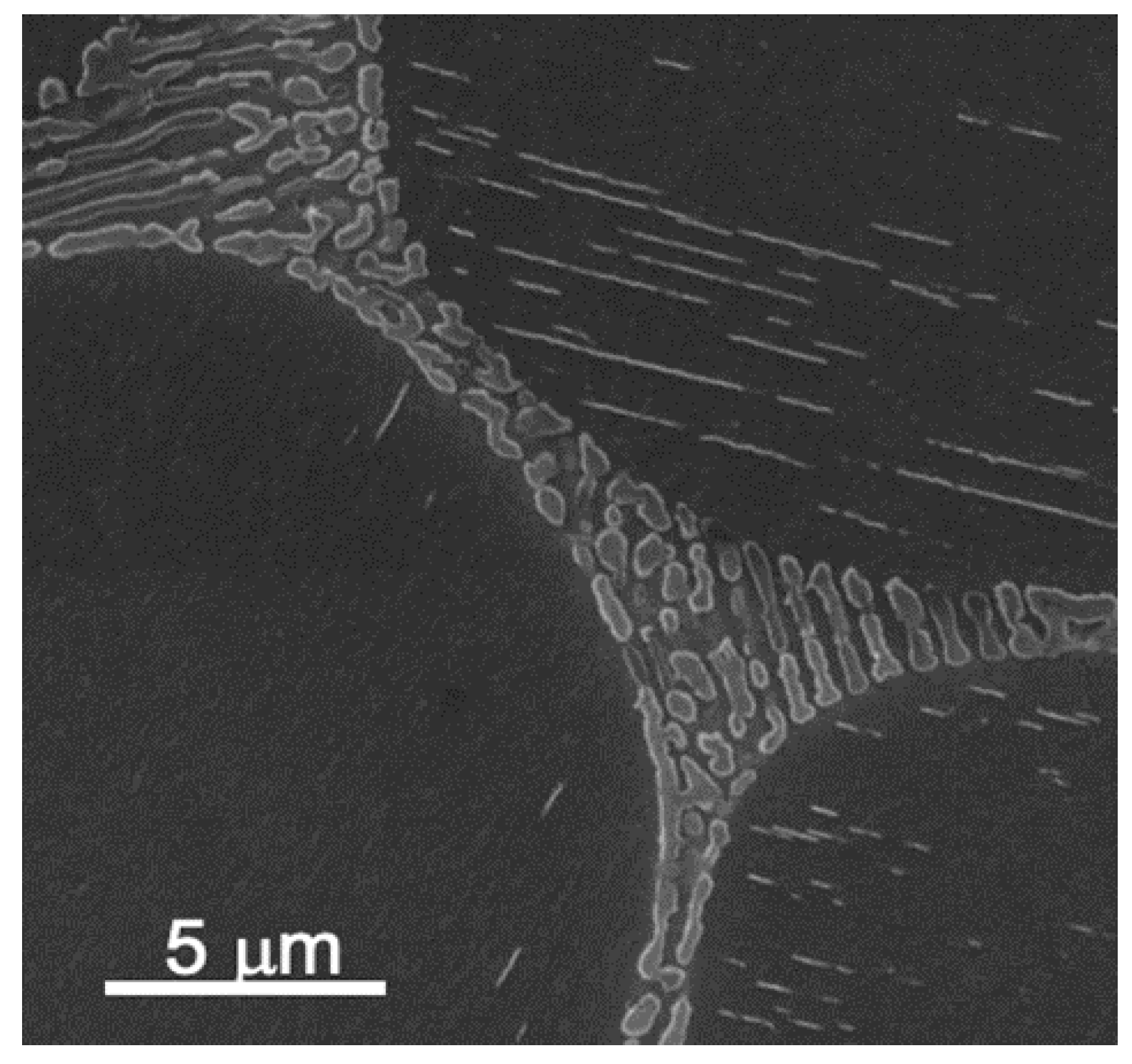
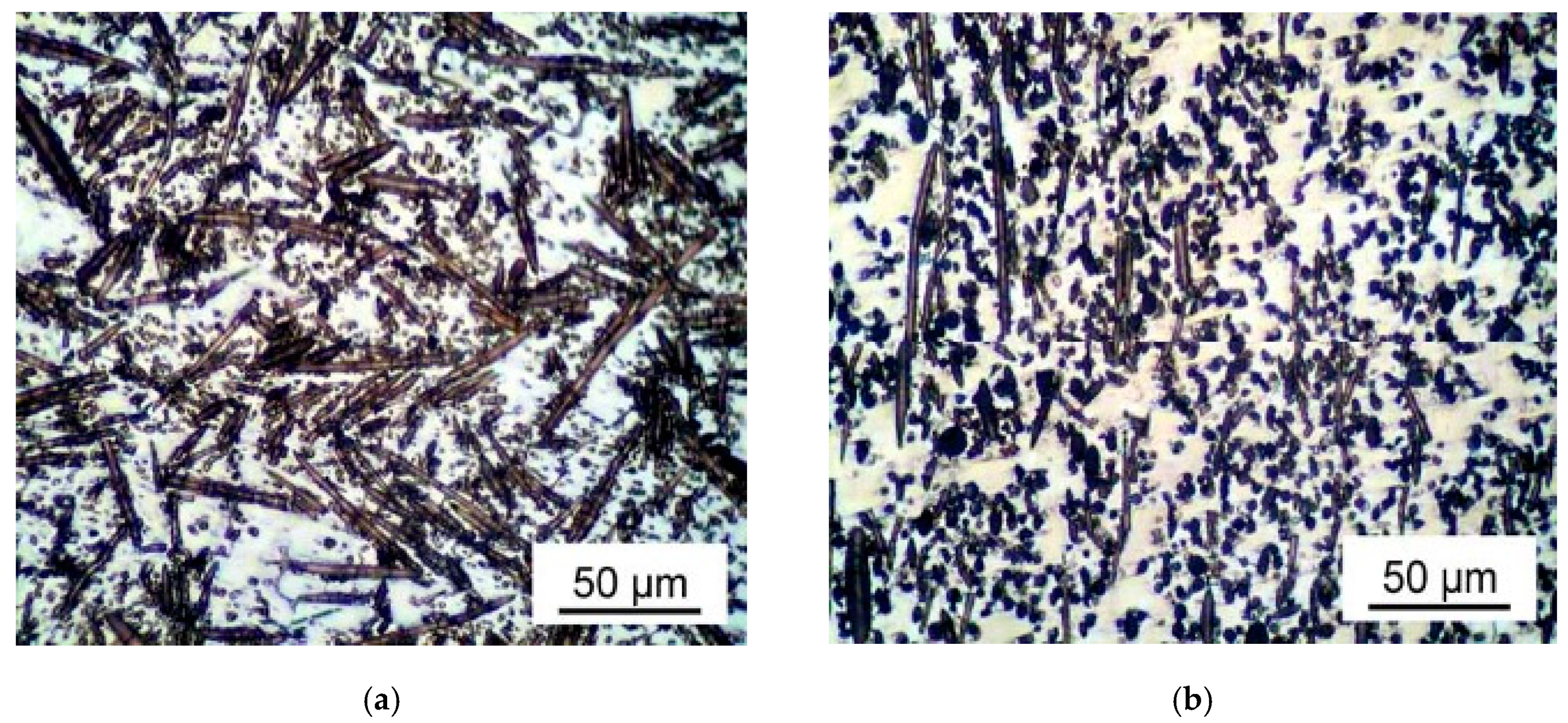
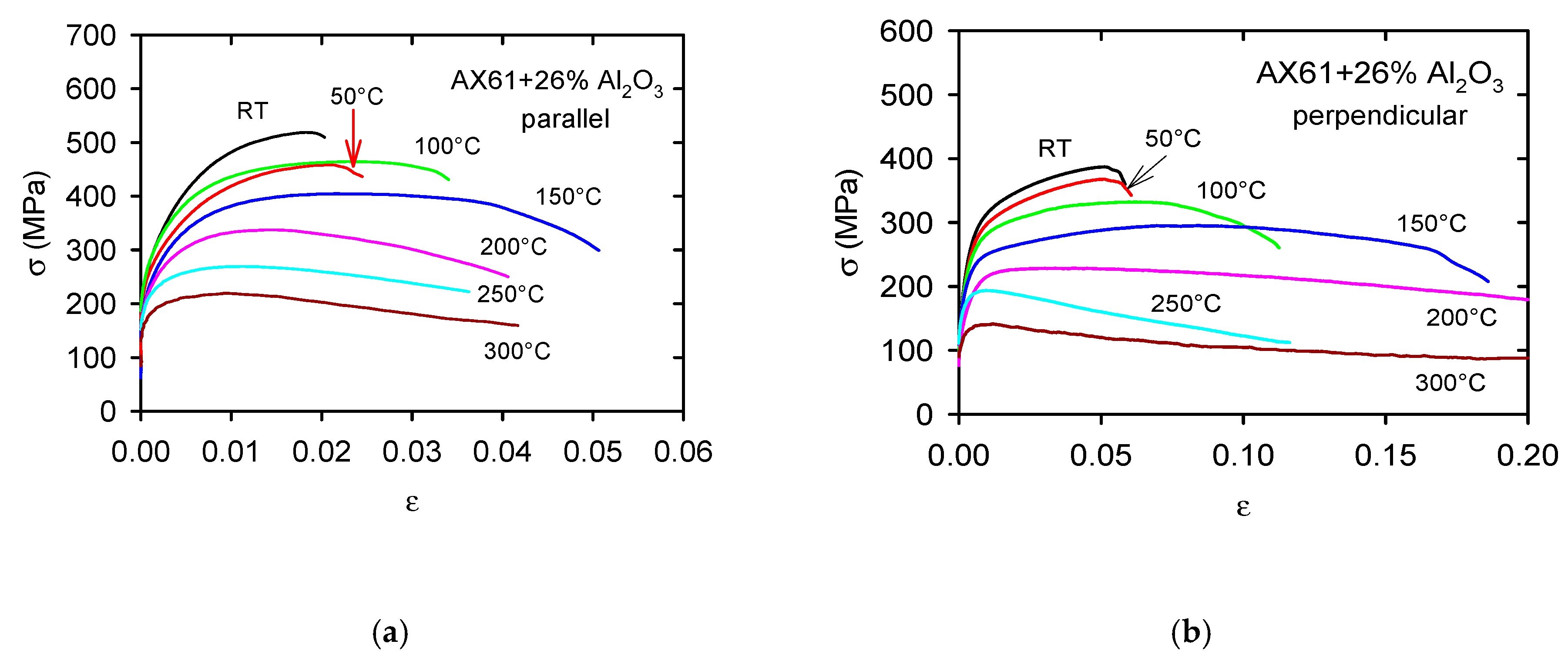
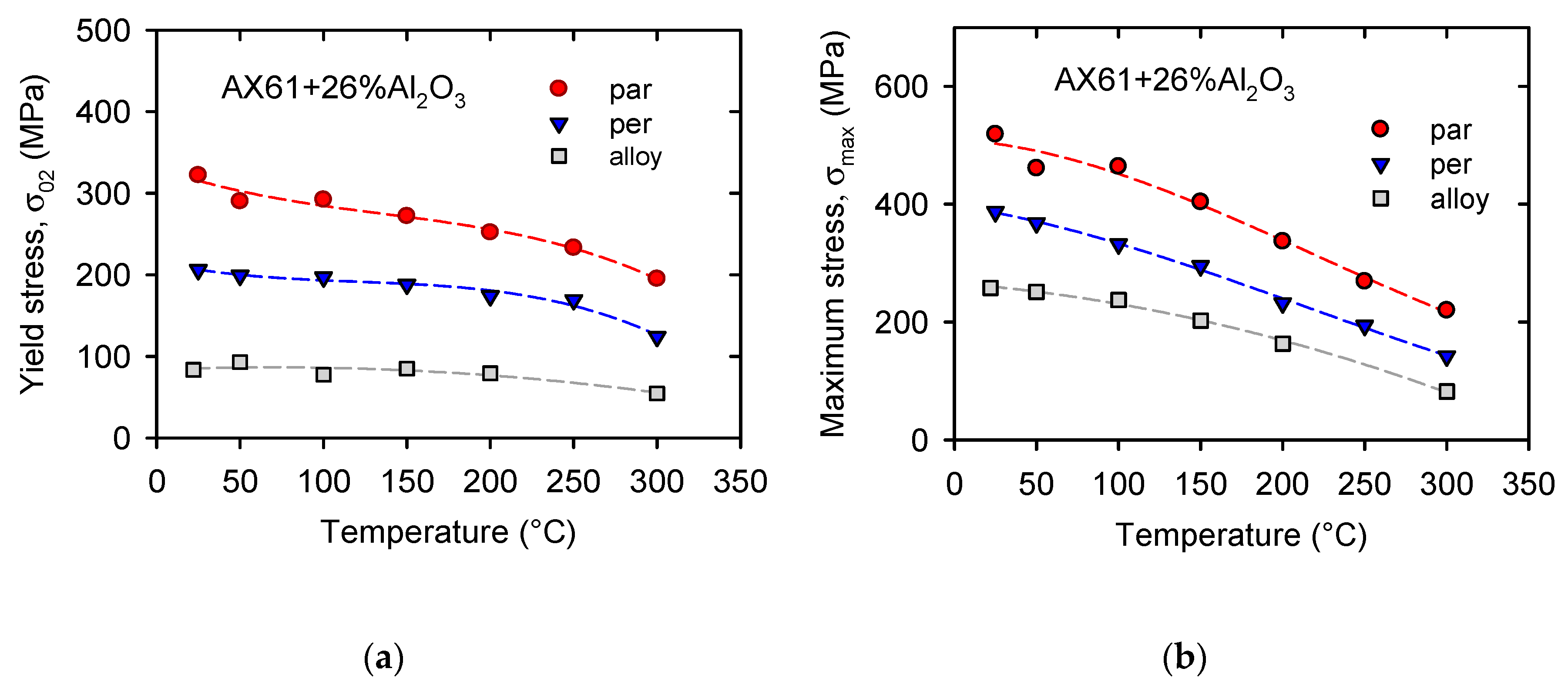
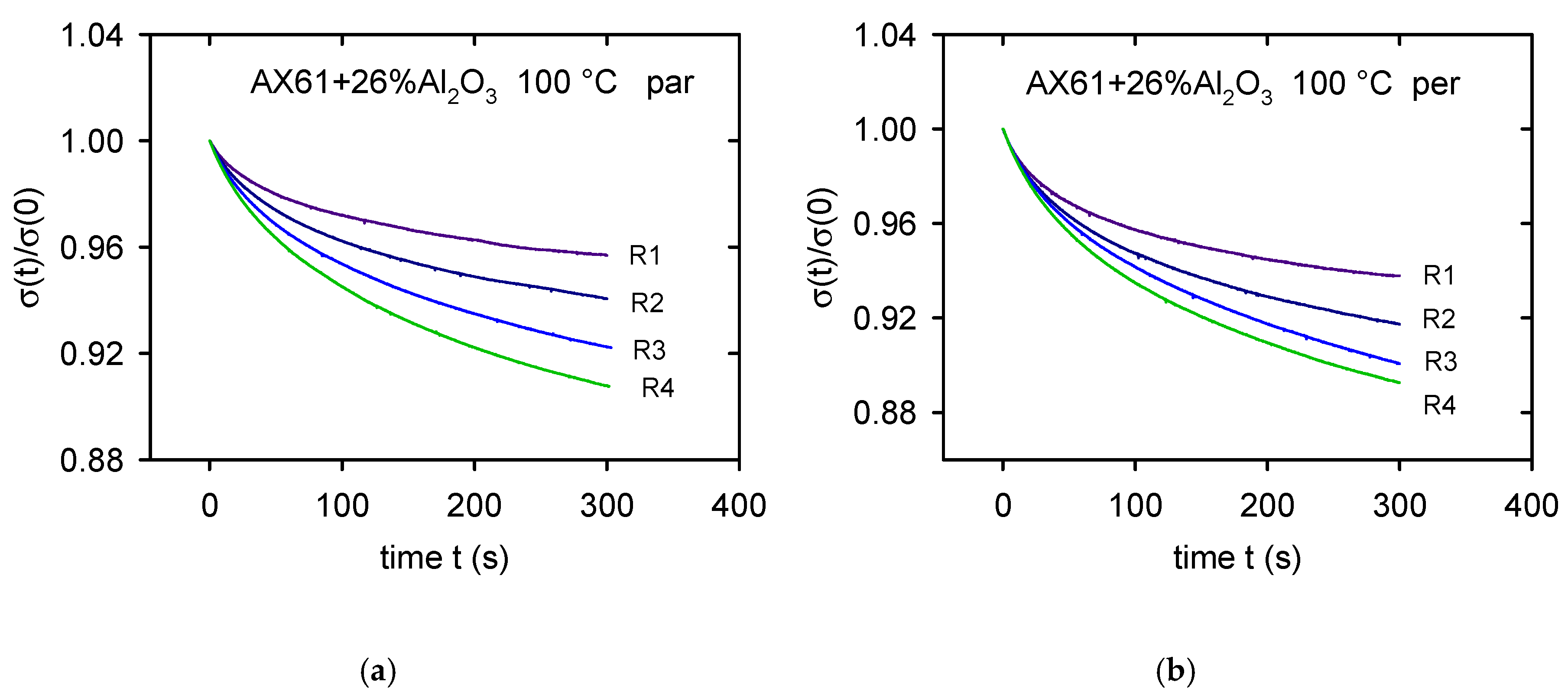
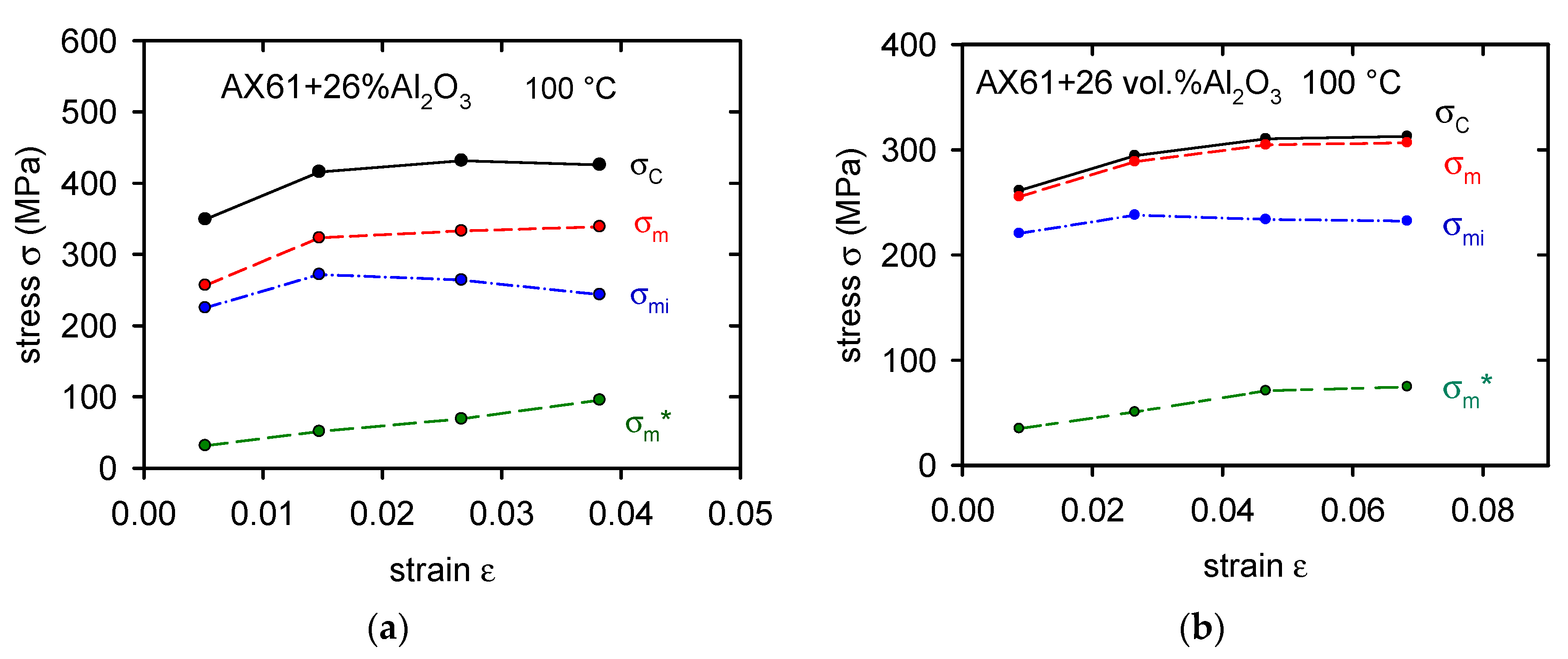
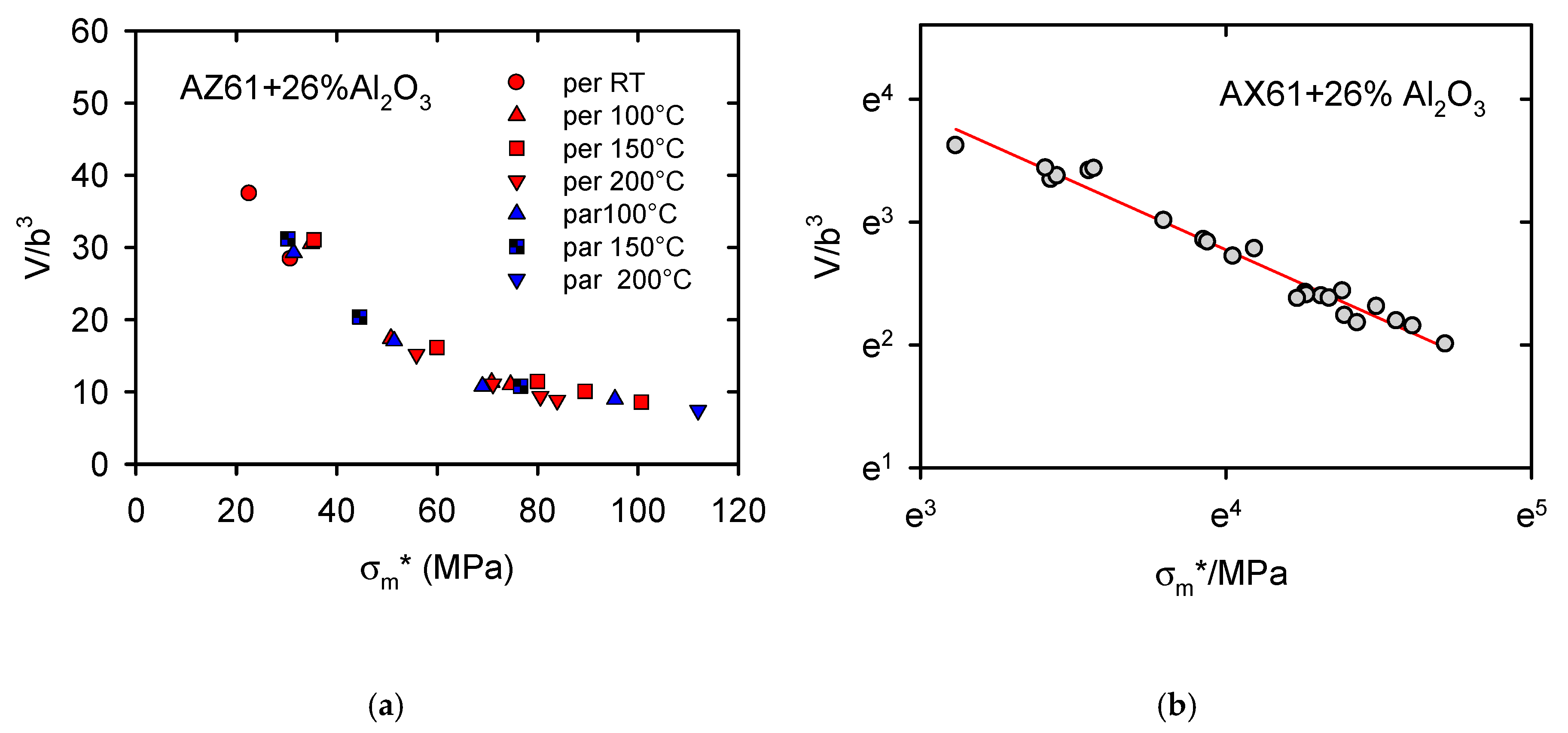
| Mechanism | Relationship |
|---|---|
| Load transfer | |
| Thermal mismatch | |
| Enhanced dislocation density | ΔσD =α1 ψGb(ρT + ρG )1/2 |
| Geometrical dislocations | |
| Orowan strengthening | |
| Residual stresses | |
| Hall-Petch strengthening |
| σLT | ρT | ρG | σOR | <σm>max | ΔσGS | G |
|---|---|---|---|---|---|---|
| L fibre length, t fibre thickness, σA alloy stress, χ = L/t | b Burgers vector, B = 10 for fibres, ΔαΔT thermal strain | εp plastic strain f volume fraction of fibres | Λ distance between fibres | σy yield stress in the matrix | Ky Hall-Pech constant, d grain size | shear modulus |
| σLT (MPa) | ρT (m−2) | ρG (m−2) | ΔσD (MPa) | σOR (MPa) | <σ>max (MPa) | ΔσGS (MPa) | σm(MPa) | σexp (MPa) | σtheor (MPa) |
|---|---|---|---|---|---|---|---|---|---|
| 95 | 4.8 × 1013 | 4.3 × 1012 | 63.3 | 3 | 48 | 20.4 | 153.3 | 322 | 320 |
© 2020 by the authors. Licensee MDPI, Basel, Switzerland. This article is an open access article distributed under the terms and conditions of the Creative Commons Attribution (CC BY) license (http://creativecommons.org/licenses/by/4.0/).
Share and Cite
Trojanová, Z.; Száraz, Z.; Lukáč, P.; Drozd, Z.; Džugan, J. Strengthening and Thermally Activated Processes in an AX61/Saffil Metal Matrix Composite. Crystals 2020, 10, 466. https://doi.org/10.3390/cryst10060466
Trojanová Z, Száraz Z, Lukáč P, Drozd Z, Džugan J. Strengthening and Thermally Activated Processes in an AX61/Saffil Metal Matrix Composite. Crystals. 2020; 10(6):466. https://doi.org/10.3390/cryst10060466
Chicago/Turabian StyleTrojanová, Zuzanka, Zoltán Száraz, Pavel Lukáč, Zdeněk Drozd, and Ján Džugan. 2020. "Strengthening and Thermally Activated Processes in an AX61/Saffil Metal Matrix Composite" Crystals 10, no. 6: 466. https://doi.org/10.3390/cryst10060466
APA StyleTrojanová, Z., Száraz, Z., Lukáč, P., Drozd, Z., & Džugan, J. (2020). Strengthening and Thermally Activated Processes in an AX61/Saffil Metal Matrix Composite. Crystals, 10(6), 466. https://doi.org/10.3390/cryst10060466







